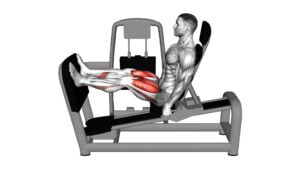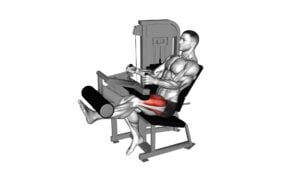Lever Seated Single Leg Press (VERSION 2) – Video Exercise Guide & Tips

Get ready to take your leg press workout to the next level with the Lever Seated Single Leg Press (Version 2).
Watch This Exercise Video
In this video exercise guide, we'll show you the proper machine setup and guide you through executing the exercise with precision.
Learn about common mistakes to avoid, variations and modifications, and our top tips for maximizing your leg press workout.
Get ready to strengthen and tone your legs like never before.
Let's get started!
Key Takeaways
- Proper machine setup is important, including positioning the back against the seat and feet firmly planted on the footplate.
- When executing the exercise, it is important to align the knee with the pivot point and press against the foot platform to extend the leg while keeping the back straight.
- Common mistakes to avoid include improper seat position, lack of core stability, incomplete range of motion, and not engaging the targeted leg muscles.
- Variations and modifications can be made to the exercise, such as adjusting the resistance level, foot placement, and tempo, to target specific muscle groups and avoid overloading the muscles.
Proper Machine Setup
To properly set up the lever seated single leg press machine, position yourself with your back against the seat and your feet firmly planted on the footplate. Begin by adjusting the machine to fit your body. Most machines have adjustable seats and footplates, allowing you to customize the settings to your height and comfort level. Ensure that the seat is at a height where your knees are bent at a 90-degree angle when your feet are on the footplate. This will help maintain proper form and prevent strain on your joints.
Once the seat is adjusted, focus on foot placement. Your feet should be shoulder-width apart, with your toes pointing slightly outward. This stance provides stability and allows for proper engagement of the leg muscles. It also helps prevent any unnecessary strain on the knees.
Take a moment to double-check the machine adjustment and foot placement before beginning your workout. By following these steps, you'll optimize your performance and reduce the risk of injury.
Executing the Lever Seated Single Leg Press
To execute the Lever Seated Single Leg Press with precision and effectiveness, focus on maintaining proper form and engaging the targeted leg muscles throughout the entire exercise. Start by sitting on the machine and placing your foot on the platform, ensuring that your knee is aligned with the pivot point. Adjust the seat and foot platform to a position that allows your knee to be at a 90-degree angle when your foot is fully extended.
Once in position, firmly press against the foot platform to extend your leg, keeping your back straight against the backrest. Avoid locking your knee at the top of the movement to maintain tension in the leg muscles. Slowly lower the weight by bending your knee, allowing the foot platform to move towards you.
Maintain control throughout the exercise, focusing on the contraction of the targeted leg muscles. Keep your core engaged and avoid arching your back or using momentum to complete the movement.
Common Mistakes to Avoid
You frequently make the mistake of not maintaining proper form and engaging the targeted leg muscles while executing the Lever Seated Single Leg Press. To avoid injury and maximize the effectiveness of this exercise, it's crucial to perform it correctly.
Here are some common mistakes to avoid:
- Improper seat position: Make sure the seat is adjusted to the appropriate height, allowing your knee to be in line with the lever's pivot point. This ensures proper biomechanics and prevents unnecessary strain on your joints.
- Lack of core stability: Engage your core muscles throughout the exercise to stabilize your body. This will help maintain proper form and prevent excessive pressure on your lower back.
- Incomplete range of motion: Avoid the mistake of not fully extending your leg or not bending it enough during the movement. To target the leg muscles effectively, aim for a full range of motion, keeping your movements controlled and smooth.
By focusing on these key points and maintaining proper form, you can prevent injuries and optimize your results during the Lever Seated Single Leg Press exercise.
Remember to consult with a fitness professional if you have any concerns or questions about proper execution.
Variations and Modifications
One variation and modification of the Lever Seated Single Leg Press is adjusting the resistance level to challenge your muscles. By increasing or decreasing the weight stack, you can target specific muscle groups and increase the intensity of your workout. Adjusting the resistance level not only helps in building strength, but it also aids in injury prevention by allowing you to gradually progress and avoid overloading your muscles.
Furthermore, modifying the foot placement on the footplate can also provide variations to the exercise. Placing your foot higher on the footplate targets the glutes and hamstrings, while placing it lower targets the quadriceps. This allows for muscle activation in different areas of the leg, providing a well-rounded workout.
Another modification is the tempo at which you perform the exercise. Slow and controlled movements can increase muscle activation and enhance muscular endurance. On the other hand, performing the exercise with a faster tempo can improve power and explosiveness.
Incorporating these variations and modifications into your Lever Seated Single Leg Press routine can help prevent injuries and maximize muscle activation. Remember to listen to your body and adjust the resistance level, foot placement, and tempo according to your fitness level and goals.
Tips for Maximizing Your Leg Press Workout
By implementing strategic techniques, you can optimize the effectiveness of your Lever Seated Single Leg Press workout. Here are some tips to help you maximize your leg press workout:
- Proper foot placement: Position your feet shoulder-width apart on the footplate and ensure that your toes are pointed slightly outward. This stance will target your quads, hamstrings, and glutes effectively.
- Adjust the seat position: To target different muscle groups, adjust the seat position. Lowering the seat will engage your glutes and hamstrings, while raising it will emphasize your quads.
- Vary the weight and repetitions: To challenge your muscles and promote growth, vary the weight and repetitions. For strength gains, use heavier weights and perform fewer reps. For endurance and toning, use lighter weights and perform more reps.
- Control the movement: Focus on performing the exercise with controlled and smooth movements. Avoid locking out your knees at the top of the movement, as this can put unnecessary stress on your joints.
- Take advantage of the benefits: The leg press exercise offers various benefits, including improved leg strength, muscle hypertrophy, and increased bone density. It also allows you to target specific muscles, such as the quadriceps, hamstrings, and glutes, by adjusting your foot placement and seat position.
Frequently Asked Questions
How Long Should I Rest Between Sets When Performing the Lever Seated Single Leg Press?
When performing the lever seated single leg press, it's important to give yourself enough rest between sets to ensure proper form and prevent fatigue.
The rest duration will vary depending on your fitness level and goals, but a general guideline is to rest for 1-2 minutes between sets.
This allows your muscles to recover and maintain good technique throughout the exercise.
Remember to listen to your body and adjust the rest duration as needed.
Can I Incorporate the Lever Seated Single Leg Press Into My Full Body Workout Routine?
Yes, you can incorporate the lever seated single leg press into your full body workout routine.
Incorporating leg press variations like this exercise can provide several benefits. Single leg exercises help to improve balance, stability, and overall lower body strength.
By targeting one leg at a time, you can also identify and correct any muscle imbalances.
Adding the lever seated single leg press to your routine will contribute to a well-rounded workout and help you achieve your fitness goals.
Is It Normal to Feel Some Discomfort in My Knees While Performing the Lever Seated Single Leg Press?
Feeling some discomfort in your knees while performing the lever seated single leg press isn't normal. It could be a sign of improper form or excessive load. Make sure you maintain proper alignment, keeping your knee in line with your toes throughout the exercise.
Adjust the seat and foot position to ensure a comfortable range of motion.
If the discomfort persists, it's advisable to consult a fitness professional or healthcare provider for further guidance.
Can I Perform the Lever Seated Single Leg Press if I Have a Pre-Existing Knee Injury?
If you have a pre-existing knee injury, it's important to prioritize injury management and avoid aggravating your condition. The lever seated single leg press may not be suitable for you, as it puts direct pressure on the knees. However, there are modifications that can be made to accommodate knee injuries, such as reducing the range of motion or using lighter weights.
Consulting with a qualified fitness professional or physical therapist can provide guidance on how to adapt this exercise to your specific needs.
How Often Should I Include the Lever Seated Single Leg Press in My Leg Workout Routine for Optimal Results?
To optimize results, include the lever seated single leg press in your leg workout routine regularly. The frequency will depend on your fitness level and goals.
This exercise targets your leg muscles, helping to strengthen and tone them. It also improves stability and balance.
Conclusion
In summary, the lever seated single leg press is an effective and efficient exercise for targeting the leg muscles. By following proper machine setup and executing the exercise with correct form, you can avoid common mistakes and maximize your leg press workout.
Remember to start with lighter weights and gradually increase the intensity to challenge your muscles. With variations and modifications available, you can tailor the exercise to your fitness level and goals.

Author
Years ago, the spark of my life’s passion ignited in my mind the moment I stepped into the local gym for the first time. The inaugural bead of perspiration, the initial endeavor, the very first surge of endorphins, and a sense of pride that washed over me post-workout marked the beginning of my deep-seated interest in strength sports, fitness, and sports nutrition. This very curiosity blossomed rapidly into a profound fascination, propelling me to earn a Master’s degree in Physical Education from the Academy of Physical Education in Krakow, followed by a Sports Manager diploma from the Jagiellonian University. My journey of growth led me to gain more specialized qualifications, such as being a certified personal trainer with a focus on sports dietetics, a lifeguard, and an instructor for wellness and corrective gymnastics. Theoretical knowledge paired seamlessly with practical experience, reinforcing my belief that the transformation of individuals under my guidance was also a reflection of my personal growth. This belief holds true even today. Each day, I strive to push the boundaries and explore new realms. These realms gently elevate me to greater heights. The unique combination of passion for my field and the continuous quest for growth fuels my drive to break new ground.







